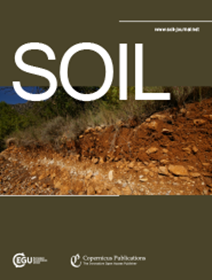Status and influential factors of soil nutrients and acidification in Chinese tea plantations: a meta-analysis
IF 4.3
2区 农林科学
Q1 SOIL SCIENCE
引用次数: 0
Abstract
Abstract. Knowledge of the status and influential factors of soil nutrients including soil organic matter (SOM), nitrogen (N), potassium (K), phosphorus (P), and acidification is the basis for sustainable management of tea plantations and thus the sustainability of the tea industry. However, a national-level study addressing this topic is lacking. Thereby, we assessed the status, spatial variations, and influential factors of soil nutrients and acidification in China's tea plantations based on 1843 datasets collected from 379 published articles. The results showed that only 40.9 % of the observed tea plantations meet the standards of high-quality tea plantations. Most tea plantations were facing soil acidification, nutrient deficiencies, and imbalance. Furthermore, the status of soil nutrients and pH varied among cultivation zones due to the impacts of location, climate, and soil type. Specifically, tea plantations in the southern zone showed the lowest concentrations of available N, available K, and total K but the highest stoichiometric ratios of soil nutrients (P < 0.05). Management practices (e.g., rotational cycle and fertilization strategies) also significantly shaped the status of soil nutrients and pH. Therefore, applying organic fertilizer, extending the duration of the cultivation cycle, and planting shading trees were recommended to improve soil nutrient availability and balance, as well as to mitigate soil acidification. Specifically, it is recommended to apply K fertilizer to tea plantations in the southern zone and/or at high altitudes.中国茶园土壤养分与酸化现状及影响因素:meta分析
摘要。了解土壤有机质(SOM)、氮(N)、钾(K)、磷(P)、酸化等土壤养分状况及其影响因素,是茶园可持续管理的基础,也是茶业可持续发展的基础。然而,缺乏针对这一主题的国家级研究。基于379篇已发表论文的1843个数据集,对中国茶园土壤养分和酸化的现状、空间变异及其影响因素进行了评估。结果表明,仅40.9%的茶园达到了优质茶园的标准。大部分茶园面临土壤酸化、养分缺乏和失衡的问题。此外,由于地理位置、气候和土壤类型的影响,不同耕作区域的土壤养分状况和pH值也存在差异。其中,南区茶园速效氮、速效钾和全钾浓度最低,土壤养分化学计量比最高(P < 0.05)。管理措施(如轮作周期和施肥策略)也显著影响了土壤养分和ph的状况。因此,建议施用有机肥、延长耕作周期和种植遮荫树来改善土壤养分的有效性和平衡,并缓解土壤酸化。具体来说,建议在南方地区和/或高海拔地区的茶园施用钾肥。
本文章由计算机程序翻译,如有差异,请以英文原文为准。
求助全文
约1分钟内获得全文
求助全文
来源期刊

Soil
Agricultural and Biological Sciences-Soil Science
CiteScore
10.80
自引率
2.90%
发文量
44
审稿时长
30 weeks
期刊介绍:
SOIL is an international scientific journal dedicated to the publication and discussion of high-quality research in the field of soil system sciences.
SOIL is at the interface between the atmosphere, lithosphere, hydrosphere, and biosphere. SOIL publishes scientific research that contributes to understanding the soil system and its interaction with humans and the entire Earth system. The scope of the journal includes all topics that fall within the study of soil science as a discipline, with an emphasis on studies that integrate soil science with other sciences (hydrology, agronomy, socio-economics, health sciences, atmospheric sciences, etc.).
 求助内容:
求助内容: 应助结果提醒方式:
应助结果提醒方式:


